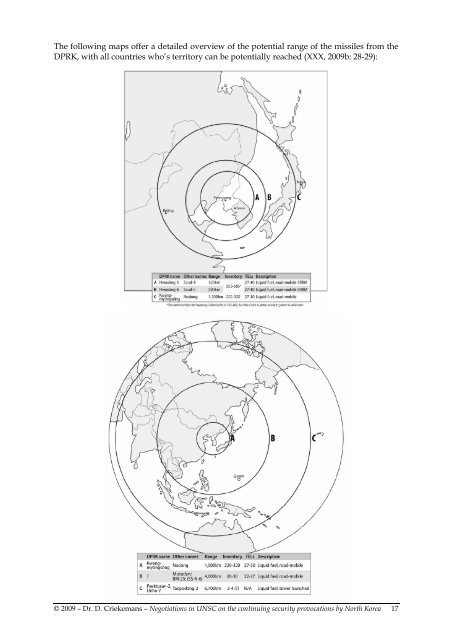Annex 5: United Nations Security Council Resolution 1874 (2009)
Annex 5: United Nations Security Council Resolution 1874 (2009) Annex 5: United Nations Security Council Resolution 1874 (2009)
The DPRK’s fast growing missile capabilities North Korea began its missile development program in the 1970s and tested an "indigenous" Scud-B ballistic missile in April 1984. In its short-range arsenal, Pyongyang has produced the 500km-range Scud-C, the 800km-range Scud-D, and the KN-02 which is an upgraded version of the Russian SS-21 "Scarab" with slightly longer range, about 100 to 120km. In its medium and intermediate-range arsenal, North Korea has the 1300km-range missile known as the Nodong (Rodong) which it initially tested in 1993 (500km) and again in 2006. North Korea has deployed about 175-200 Nodong missiles. In August 1998, North Korea flight-tested the two-stage Paektusan-1 (Taepodong-1), a 1800 km range missile, in a failed attempt to place a small satellite into earth orbit. In its second stage, it flew over the main Japanese island of Honshu and landed in the Pacific Ocean after travelling 1,380 km. North Korea has also tested anti-ship cruise missiles in 1994, 1997, 2003, and 2007. The first three were based on the CSSC-3 'Seersucker' and identified as the AG-1. The latest anti-ship cruise missile tests on 25 May and 7 June 2007 are believed to have been either the KN-01 or Chinese-made CSSC-3 ‘Seersucker’. In its long-range missile arsenal, North Korea tested the Taepodong-2 (Paektusan-2) on 5 July 2006 and 5 April 2009. The Taepodong-2 potentially has inter-continental range. However, the system failed in the 2006 test after about 40 seconds of flight. This test broke Pyongyang’s 1999 moratorium on long-range missile tests. More recently, North Korea informed the International Maritime Organization on 12 March 2009 of its intent to launch a satellite in early April. This launch was interpreted by most outside analysts and governments to be another test of the Taepodong-2 system. The 5 April 2009 launch, like the 2006 test, was a technical failure, with the multistage rocket crashing into the Pacific Ocean without the detachment of the second and third stages and its payload. North Korea is also a major exporter of missile technology. North Korea has exported missiles, missile components, and technology to Egypt, Iran, Libya, Pakistan, Syria, and Yemen. United States and Spanish naval forces intercepted a North Korean ship in December 2002 loaded with Scud missiles, but then allowed the ship to proceed to deliver the missiles to Yemen. In late January 2004, North Korea and Nigeria reportedly agreed to a missile deal, but Nigeria backed out of the agreement in early February under U.S. pressure. North Korea is not a member of the Missile Technology Control Regime (Source: www.nti.org ). © 2009 – Dr. D. Criekemans – Negotiations in UNSC on the continuing security provocations by North Korea 16
The following maps offer a detailed overview of the potential range of the missiles from the DPRK, with all countries who’s territory can be potentially reached (XXX, 2009b: 28-29): © 2009 – Dr. D. Criekemans – Negotiations in UNSC on the continuing security provocations by North Korea 17
- Page 1 and 2: Vereniging voor de Verenigde Naties
- Page 3 and 4: eprocessing. The administration of
- Page 5 and 6: of the Korean Peninsula, which proh
- Page 7 and 8: With UNSC 1874 (2009), all Council
- Page 9 and 10: On Sunday June 25 th, 1950, Kim Il-
- Page 11 and 12: - Scenario 2: MESSY TRANSITION The
- Page 13 and 14: Military North Korea is one of the
- Page 15: - A plutonium reprocessing plant ab
- Page 19 and 20: Understanding the DPRK’s intentio
- Page 21 and 22: Understanding the positions of the
- Page 23 and 24: The United States of America: press
- Page 25 and 26: including (relatively modest) econo
- Page 27 and 28: Beware of the Dynamics in the Decis
- Page 29 and 30: - The DPRK has threatened to again
- Page 31 and 32: It is very probable that the UNSC w
- Page 33 and 34: Useful links: - - IAEA-website: In
- Page 35 and 36: -- The U.S. and DPRK will cooperate
- Page 37 and 38: ANNEX 3: Beijing Agreement of Febru
- Page 39 and 40: Annex 4: Six Parties October 3, 200
- Page 41 and 42: humanitarian and developmental purp
- Page 43 and 44: “8. Decides that the DPRK shall a
- Page 45 and 46: documents of 13 February 2007 and 3
- Page 47 and 48: ABDURRAHMAN MOHAMED SHALGHAM (Libya
The following maps offer a detailed overview of the potential range of the missiles from the<br />
DPRK, with all countries who’s territory can be potentially reached (XXX, <strong>2009</strong>b: 28-29):<br />
© <strong>2009</strong> – Dr. D. Criekemans – Negotiations in UNSC on the continuing security provocations by North Korea 17



